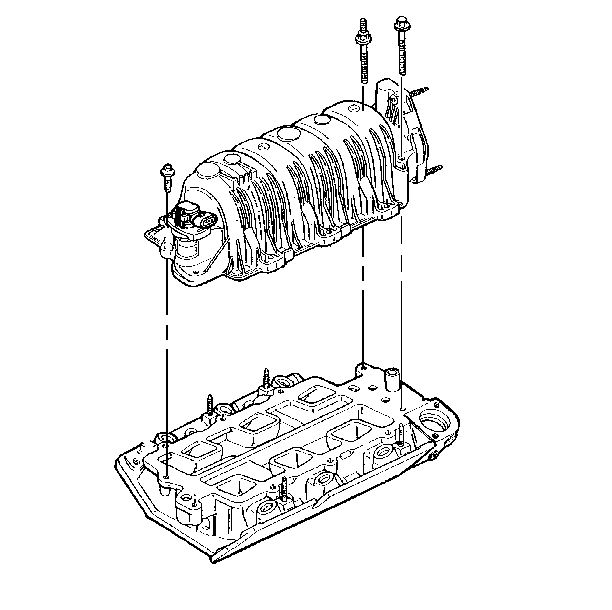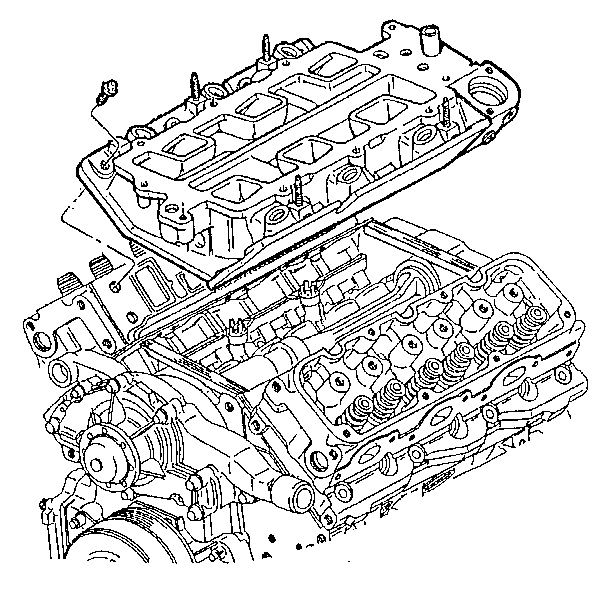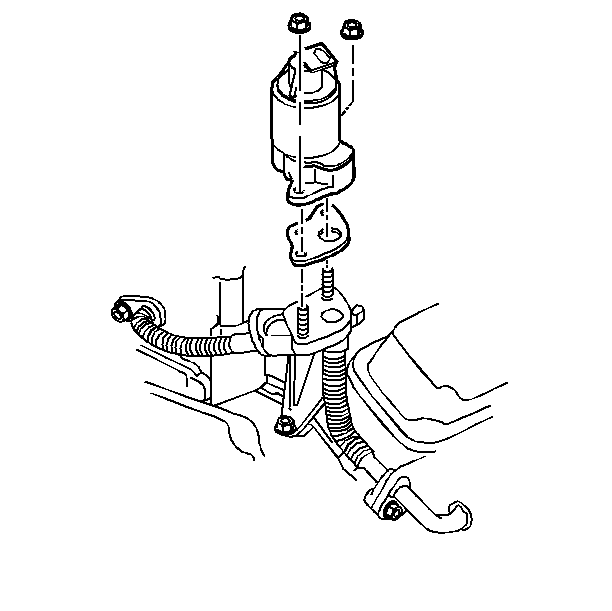Intake Manifold Replacement Upper - VIN K
Removal Procedure
- Disconnect the negative battery cable. Refer to
Caution: Unless directed otherwise, the ignition and start switch must be in the OFF or LOCK position, and all electrical loads must be OFF before servicing any electrical component. Disconnect the negative battery cable to prevent an electrical spark should a tool or equipment come in contact with an exposed electrical terminal. Failure to follow these precautions may result in personal injury and/or damage to the vehicle or its components.
in General Information. - Remove the fuel injector sight shield.
- Remove the air intake duct.
- Disconnect the spark plug wires from the right side of the engine. Set the wires aside.
- Remove the manifold vacuum source.
- Depressurize the fuel lines. Refer to Fuel System Pressure Relief in Engine Controls.
- Remove the fuel rail.
- Remove the EGR heat shield.
- Remove the cable bracket to the cylinder head mounting bolt.
- Remove the throttle cable.
- Remove the throttle body support bracket.
- Remove the upper intake manifold bolts.
- Remove the upper intake manifold.

Installation Procedure
- Install the upper intake manifold.
- Install the upper intake manifold bolts.
- Install the throttle body support bracket.
- Install the throttle body cable.
- Install the cable bracket to the cylinder head mounting bolt.
- Install the EGR heat shield.
- Install the fuel rail.
- Install the manifold vacuum source.
- Connect the spark plug wire to the right side of the engine.
- Install the fuel injector sight shield.
- Install the air intake duct.
- Connect the negative battery cable.

Tighten
Tighten the bolts to 10 N·m (89 lb in).
Notice: Use the correct fastener in the correct location. Replacement fasteners must be the correct part number for that application. Fasteners requiring replacement or fasteners requiring the use of thread locking compound or sealant are identified in the service procedure. Do not use paints, lubricants, or corrosion inhibitors on fasteners or fastener joint surfaces unless specified. These coatings affect fastener torque and joint clamping force and may damage the fastener. Use the correct tightening sequence and specifications when installing fasteners in order to avoid damage to parts and systems.
Intake Manifold Replacement Lower - VIN K
Removal Procedure
- Disconnect the negative battery cable. Refer to
Caution: Unless directed otherwise, the ignition and start switch must be in the OFF or LOCK position, and all electrical loads must be OFF before servicing any electrical component. Disconnect the negative battery cable to prevent an electrical spark should a tool or equipment come in contact with an exposed electrical terminal. Failure to follow these precautions may result in personal injury and/or damage to the vehicle or its components.
in General Information. - Remove the upper intake manifold. Refer to Intake Manifold Replacement .
- Drain the cooling system. Refer to Draining and Filling the Coolant System in Engine Cooling.
- Remove the upper radiator hose. Refer to Upper Radiator Hose Replacement in Engine Cooling.
- Remove the generator. Refer to Generator Replacement in Engine Electrical.
- Remove the drive belt tensioner. Refer to Drive Belt Replacement .
- Remove the EGR valve outlet pipe. Refer to EGR Valve, Adapter, and Pipes Replacement in Engine Controls.
- Remove the lower intake manifold bolts.
- Remove the lower intake manifold.
Notice: Engine Code K has two bolts which are hidden beneath the upper intake. These bolts are located in the right front and left rear corners of the lower intake manifold. It is necessary to remove the upper intake manifold to service the lower intake.

Installation Procedure
Important: In order to complete the installation, observe the following assembly tips:
| • | Clean the cylinder block, heads and the intake manifold sealing surface of all oil with a suitable solvent. |
| • | Clean the intake manifold bolts and bolt holes of adhesive compound. |
| • | Apply GM approved thread locking compound to the intake manifold bolt threads before assembly. |
- Install the lower intake manifold.
- Install the lower intake manifold bolts.
- Connect the negative battery cable.
- Install the EGR valve outlet pipe. Refer to EGR Valve, Adapter, and Pipes Replacement in Engine Controls.
- Install the drive belt tensioner. Refer to Drive Belt Replacement .
- Install the generator. Refer to Generator Replacement in Engine Electrical.
- Install the upper radiator hose. Refer to Upper Radiator Hose Replacement in Engine Cooling.
- Fill the cooling system. Refer to Draining and Filling the Coolant System in Engine Cooling.
- Install the upper intake manifold. Refer to Intake Manifold Replacement .
- Connect the negative battery cable.

Tighten
Tighten the bolts in sequence to 15 N·m (11 lb in).
Notice: Use the correct fastener in the correct location. Replacement fasteners must be the correct part number for that application. Fasteners requiring replacement or fasteners requiring the use of thread locking compound or sealant are identified in the service procedure. Do not use paints, lubricants, or corrosion inhibitors on fasteners or fastener joint surfaces unless specified. These coatings affect fastener torque and joint clamping force and may damage the fastener. Use the correct tightening sequence and specifications when installing fasteners in order to avoid damage to parts and systems.
Intake Manifold Replacement Complete - VIN 1
Removal Procedure
- Disconnect the negative battery cable. Refer to
Caution: Unless directed otherwise, the ignition and start switch must be in the OFF or LOCK position, and all electrical loads must be OFF before servicing any electrical component. Disconnect the negative battery cable to prevent an electrical spark should a tool or equipment come in contact with an exposed electrical terminal. Failure to follow these precautions may result in personal injury and/or damage to the vehicle or its components.
in General Information. - Raise the vehicle. Suitably support the vehicle. Refer to Section 0A.
- Remove the front splash shield.
- Drain the coolant. Refer to Draining and Filling the Coolant System in Engine Cooling.
- Close the radiator drain cock.
- Install the front splash shield.
- Lower the vehicle.
- Remove the supercharger. Refer to Supercharger Replacement .
- Remove the thermostat housing.
- Remove the EGR tube at the intake manifold.
- Disconnect the electrical connection at the temperature sensor.
- Remove the intake manifold.


Installation Procedure
Important: In order to install the manifold, complete the following steps:
• Use a suitable solvent in order to clean all oil from the cylinder
block, the cylinder heads, and the intake manifold sealing surface. • Apply a GM approved sealer to the ends of the intake manifold
seals. • Clean any adhesive compound from the intake manifold bolts and
the bolt holes. • Apply a GM approved thread locking compound to the intake manifold
bolts.
- Install the intake manifold.
- Install the intake manifold bolts.
- Install the electrical connector at the temperature sensor.
- Install the EGR tube to the intake manifold.
- Install the thermostat housing.
- Install the supercharger. Refer to Supercharger Replacement
- Refill the coolant. Refer to Draining and Filling the Coolant System in Engine Cooling.
- Connect the negative battery cable.

Tighten
Tighten the intake manifold bolts in sequence to 15 N·m
(11 lb ft).
Notice: Use the correct fastener in the correct location. Replacement fasteners must be the correct part number for that application. Fasteners requiring replacement or fasteners requiring the use of thread locking compound or sealant are identified in the service procedure. Do not use paints, lubricants, or corrosion inhibitors on fasteners or fastener joint surfaces unless specified. These coatings affect fastener torque and joint clamping force and may damage the fastener. Use the correct tightening sequence and specifications when installing fasteners in order to avoid damage to parts and systems.

